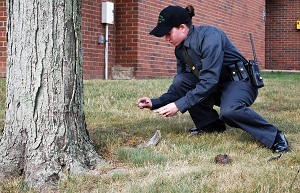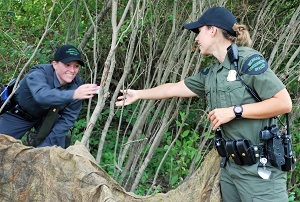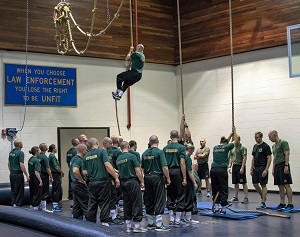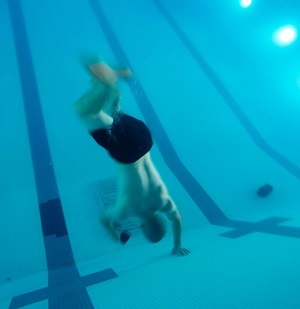Patrols, investigations keep DNR conservation officers busy
Week 6: Aug. 20-26, 2017
While there probably isn’t a typical day for Michigan conservation officers, trainees in Week 6 of the Department of Natural Resources Conservation Officer Recruit School got their best feel yet for how they will spend much of their time – if they make the grade.
Cracking the case
Monday morning found recruits ready to tackle some hands-on learning. They began with a classroom session led by Conservation Officer Shannon Kritz, who explained the basics of performing patrol-area checks. The checks are a big part of a conservation officer’s routine. While traditional law enforcement officers often spend a large part of their time conducting traffic stops, conservation officers are out in a variety of settings, checking hunters and outdoor enthusiasts to make sure they are enjoying their pastimes safely and legally.
Recruits then left the classroom to put their knowledge into practice. The ability to “read” the scene of an investigation is critical in law enforcement. Each recruit participated in a scenario in which a ruffed grouse supposedly was shot with a handgun within the safety zone of a building. The recruit then had to identify the feathers left behind, locate the spent ammunition casings and correctly identify that the shot  was fired within the safety zone of an occupied dwelling. was fired within the safety zone of an occupied dwelling.
Additional scenarios were waiting for recruits after lunch, and each one demanded that recruits tap the knowledge they have gained since day one. The practice sessions required recruits to respond to complaints involving illegal bear baiting, illegally posting state land, including a hunting blind violation; illegal trapping, or littering.
Recruits were responsible for following their respective scenarios from start to finish. As they someday will do as conservation officers, recruits first checked in with the Report All Poaching (RAP) communications center to receive the complaint. They then drove to the location and examined it for evidence of a crime, with a conservation officer alongside them all the while, providing constructive critiques of their every move. Recruits completed the process by preparing an incident report, which was scrutinized by academy staff for accuracy, attention to detail and professionalism.
Weapons laws and violations
Tuesday brought the opportunity for recruits to see a variety of confiscated weapons. Retired Michigan State Police inspector David Greydanus, a familiar face to the class, let recruits examine the weapons to emphasize his points on weapons laws and violations.
On Wednesday, the class was immersed in learning policies and procedures of the DNR Law Enforcement Division. Capt. Tim Robson explained their importance to the duties and safety of conservation officers. “Good policies help police offers make the best possible decisions in critical situations,” he said. “Policies make sure law enforcement agencies comply with laws, industry standards and case laws.” Division. Capt. Tim Robson explained their importance to the duties and safety of conservation officers. “Good policies help police offers make the best possible decisions in critical situations,” he said. “Policies make sure law enforcement agencies comply with laws, industry standards and case laws.”
But the day wasn’t all about lectures. As usual, physical training was a big part of the recruits’ routine, with one of Wednesday’s workout highlights being good, old-fashioned rope climbing. Rope climbing is a time-honored exercise that builds agility and upper-body strength, two critical traits for conservation officers.
The right approach
The legal training from earlier in the week carried into Thursday. This time, though, it was reinforced with scenarios involving illegal weapons.
Friday’s emphasis was on proper procedures for stopping vehicles and, if necessary, controlling vehicle occupants. Conservation Officers Shane Webster and Troy Van Gelderen led the instruction, explaining the positioning and approach needed to ensure officer safety and that contacts are handled in a professional manner. Since routine traffic stops can quickly turn bad, recruits were taught how to position their vehicles and themselves to maximize safety and  effectiveness. Recruits also had the chance to drive a DNR patrol truck and practice pulling over a vehicle that was participating in the scenario, to put their skills to use. effectiveness. Recruits also had the chance to drive a DNR patrol truck and practice pulling over a vehicle that was participating in the scenario, to put their skills to use.
No day is complete without physical training, of course, and Friday was no different. The day’s workout included time in the swimming pool – or “tank” as it is called by veteran officers – to build stamina and enhance the water safety skills learned by recruits earlier in the academy.
Before being dismissed for the weekend, recruits learned more about report writing and reviewed earlier test results with Sgt. Jason Wicklund, Recruit School commander. With 17 weeks still left in the academy, the tests and report writing won’t end anytime soon. Recruits continually will be tested on what they have learned and will be expected to demonstrate proficiency.
But that’s part of the deal, as recruits knew when they agreed to take on one of the biggest challenges of their young lives.
Subscribe to the weekly conservation officer academy blog, which also will be posted on the Michigan DNR Facebook page. View previous blogs from Recruit School #8.
/Note to editors: Accompanying photos are available below for download. Caption information follows.
Gathering_clues: Conservation offers must know how to “read” a scene when conducting investigations. Pictured, a recruit goes through an evidence-collecting scenario, which includes correctly identifying feathers from a game bird, looking for spent ammunition casings, and determining whether a crime was committed.
Finding_evidence: A recruit hands Conservation Officer Shannon Kritz evidence discovered during an exercise involving a simulation of illegal baiting activity. Conservation officers must piece together all sorts of clues that may indicate violations of fish and game or environmental laws.
Heading_out: Communication is vital in law enforcement and conservation officers are always in contact with their area dispatch centers. Pictured, a recruit prepares to leave for an investigation and radios her intended destination to central dispatch.
Rope_climbing: Conservation officers are never certain what they will encounter each day, from performing lifesaving rescues to hiking through miles of rugged terrain. Rope climbing is a time-tested physical training tool that builds agility and upper-body strength, both essential traits of a conservation officer.
Making_a_splash: A recruit’s physical stamina and water safety skills are tested during Week 6 of the DNR Conservation Officer Recruit School. Conservation officers spend a lot of time on rivers, lakes and streams and must be comfortable in marine environments.
Reading_the_signs: Conservation Officer Richard Stowe helps a recruit recognize signs of beaver activity during a recent exercise. A significant part of the training during Week 6 involved realistic scenarios that took recruits away from the academy grounds.
The Michigan Department of Natural Resources is committed to the conservation, protection, management, use and enjoyment of the state’s natural and cultural resources for current and future generations. For more information, go to www.michigan.gov/dnr.
|


 was fired within the safety zone of an occupied dwelling.
was fired within the safety zone of an occupied dwelling. Division. Capt. Tim Robson explained their importance to the duties and safety of conservation officers. “Good policies help police offers make the best possible decisions in critical situations,” he said. “Policies make sure law enforcement agencies comply with laws, industry standards and case laws.”
Division. Capt. Tim Robson explained their importance to the duties and safety of conservation officers. “Good policies help police offers make the best possible decisions in critical situations,” he said. “Policies make sure law enforcement agencies comply with laws, industry standards and case laws.” effectiveness. Recruits also had the chance to drive a DNR patrol truck and practice pulling over a vehicle that was participating in the scenario, to put their skills to use.
effectiveness. Recruits also had the chance to drive a DNR patrol truck and practice pulling over a vehicle that was participating in the scenario, to put their skills to use.




